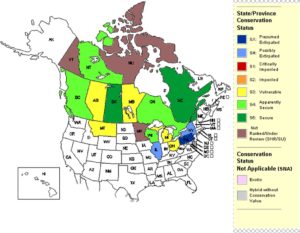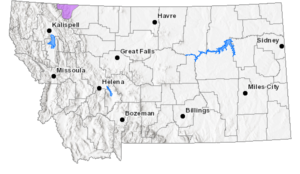Spoonhead Sculpin
Charles Baker and Michelle Anderson, University of Montana Western, Dillon, MT
David Stagliano, Montana Natural Heritage Program, Helena, MT
Status
The spoonhead sculpin is presently listed as a species of special concern (SOC) in MT due to its limited distribution (S3, vulnerable-meaning they are at risk for potential declines in population, range or habitat even though they are abundant in some areas) (MNHP 2004). This species is similarly listed as an SOC in four of the other 14 states or provinces where it presently occurs. It is thought to be extirpated in New York, Illinois and Pennsylvania (Nature Serve 2014) (Figure 1). Globally, spoonhead populations are reported to be secure (G5), not at risk (COSEWIC 1989, Nature Serve 2014) and of Least Concern by the IUCN Red List (2012). The chance of improving the spoonhead sculpin conservation rank in MT to an S4 or S5 by identifying more populations is highly unlikely due to the localized, biogeographical nature of their distribution and the small percent of the state inhabited.

Figure 1. Spoonhead sculpin range and status in North America (NatureServe 2014)
Distribution and Population Status
The extensive Canadian Range of the spoonhead includes the Great Lakes-St. Lawrence and Arctic basins from southern Quebec to the Mackenzie River drainage, Northwest Territories, Yukon, and northeastern British Columbia, and southern Alberta (Page and Burr 2011, Figure 1). Distribution of spoonhead sculpin in the United States includes the Great Lakes region, northern Ohio and Montana. This distribution pattern was formed in part by the Laurentian ice sheet, which covered large portions of the northern United States 18,000 – 10,000 years ago. This limited the distribution of many sculpin species south to the Great Plains and east to the Mississippi River. As temperatures began to rise 14,000 years ago, the ice sheet started to melt and retreated to Canada. Large river systems and deep lakes were left in the wake of the retreating glaciers. Spoonhead sculpin started repopulating ice-free areas of the US to the north and west. The Continental Divide proved to be an impassible obstruction, segregating eastern and western species of sculpin (Sullivan et. al, 2009).
The earliest recorded specimen of spoonhead sculpin in Montana was reported in 1934, for which the specific location of collection is unknown (Brown, 1971). Spoonhead sculpin (Cottus ricei) are at present considered rare in Montana. The current known range of spoonhead sculpin in Montana is restricted to the St. Mary and Waterton River drainages in Glacier National Park. Spoonheads are common in the streams of boreal forest watersheds of Canada and within the Mackenzie River, Saskatchewan River systems and Hudson Bay drainages. Records show spoonheads have been found in areas near the Montana-Alberta border including the upper Oldman River and the mainstem and Northfork of the Milk River (Paetz and Nelson, 1970).

Figure 2. Spoonhead sculpin range of Montana (MNHP2016)
Threats
Global climate change poses a significant threat to all freshwater aquatic species, especially cold-water adapted ones. U.S. Geological Survey researchers predict that slight increases in average annual air temperatures could significantly change the quality, temperature and quantity of the natural water systems around the globe (Kloepfer, 2002). The impact these changes may have on a sculpin species is unclear, especially for a glacial relict species with a restricted range such as spoonhead sculpin.
It is unknown to the extent which agricultural pollutants may be harmful to sculpin. Agriculture fertilizers such as nitrogen and phosphorous can run off into rivers, streams and irrigation ditches, causing harmful changes in water chemistry and heavy algae growth on the benthic cobbles they inhabit. Aerosol deposition of nitrogen can cause soil and water eutrophication, increasing the likelihood of rapid plant and algal growth. As an example, in Montana overall nitrogen content of Flathead Lake is increasing from fossil fuel burning and forest fires (Ellis 2006). Increasing nitrogen levels in water systems could lead to serious problems concerning all aquatic life (Vitousek et al. 1997). Sculpin can be effective tools for assessing cold water stream ecology because they are more sensitive to localized habitat alterations than many larger sport fish. This is likely due to the fact that large numbers of sculpin often occupy small areas within lakes and streams. This makes them a useful bioindicator in determining threats to both sculpin and conspecific fish species. Most sculpin are poor swimmers, making them extremely susceptible to instream barriers and diversions. Sculpin are also sensitive to metal pollutants such as Zn, Ni and Pb (Maret and MacCoy 2002). Allert et al (2009) found that sculpin densities on the Black River were lower in areas exposed to metal pollutants from nearby mining sites.
Description
The spoonhead sculpin (Cottus ricei) is a freshwater fish found uncommonly in Montana. The body of this fish is light brown in color with dark splotches covering portions of the body in contrast with its white belly and sides. The overall color varies in this species, becoming darker to the northern end of its range (Sullivan et. al, 2009). Spoonhead sculpin are scaleless with a complete lateral line. This species is commonly identified by a pair of preopercular spines located on the upper portion of each gill cover (Sullivan et al. 2009). The spines curve upward and resemble “bison horns” aiding in defense against predation. Additional small prickly spines cover portions of the body, presenting a rough defensive texture to predators. Prickles can be found covering the entire body, may be lightly present, or are missing completely. The name “spoonhead” is derived from the wide and flat shape of the head. One median pore is located under the chin, proximal to the tip of the mouth (Paetz and Nelson, 1970). The mouth of a spoonhead is small and contains no palatine teeth. Most specimens have 13-15 finrays on the anal fin (Brown, 1971), and can be found with two to four saddles under the second dorsal fin (Holton and Johnson, 1996). Average lengths for this fish ranges from 7.0-8.0 cm, with the largest recorded length at 13.5 cm from a male caught on the Oldman River in Alberta (Paetz and Nelson, 1970).
Life history and ecology
Sculpin have received considerable attention due to their ecological importance in trophic interactions with sport fishes (Schmetterling and Adams 2007). Spoonhead scuplin have been identified as an important food source for burbot, northern pike, and lake trout (Roberts 1988). Members of the Cottidae family occupy streams that are heavily populated by salmonids (Moyle and Cech, 2004). Sculpin have been known to prey on eggs and larvae of some sport fishes (Fitzsimons et. al, 2002; Tabor et. al, 2004). Interspecific interactions among spoonhead sculpin and sport fish in the St. Mary drainage are relatively unknown. Further research in Montana, particularly in the St. Mary river region could help answer questions pertaining to trophic and habitat interactions involving this species.
Sexual maturity in most spoonhead sculpin is reached during the fall of their second growing season (Selgeby 1988). Spawning of spoonhead sculpin in Alberta, generally occurs in the spring during April and May when water temperatures reach 60 C (Roberts, 1988). Spawning can also occur in late summer to early fall in shallow gravel beds along the edge of lakes, streams and rivers (Roberts 1988, Sullivan et. al 2009). Males decide the location of a nesting spot, usually being underneath a rock. Females lay up to 1600 eggs that adhere to the bottom of the rock. Males guard and fan eggs until they hatch. Egg deposition to hatch time is generally 2-3 weeks, averaging 21 days. Roberts (1988) indicates water temperatures are roughly 80 C when eggs begin to hatch. The average lifespan for spoonhead sculpin is 6 years (Sullivan et. al, 2009).
Spoonhead sculpin diet likely varies with habitat and food availability. In Lake Superior the diet of spoonheads consists mainly of burrowing amphipods and Mysid shrimp (Pontoporiea affinis) (Selgeby, 1988).
Management
Spoonhead sculpin are considered a non-game fish in Montana and not legally classified by statute or regulated by the state. Management currently falls under the jurisdiction of Montana Fish Wildlife and Parks (FWP). Detailed management for spoonhead sculpin can only be implemented when more accurate research on population dynamics can be done. A primary focus of managing the spoonhead sculpin in Montana should be to more accurately determine the population status of the species. Efforts should be made to describe its complete range, as well as to estimate abundance at locations where its presence is currently known. Populations should be routinely monitored to describe population trends over time. Additionally, further research into the life history of the species is also needed. Much of the life history of the spoonhead sculpin is poorly understood (e.g., movement), and is commonly assumed to be similar to that of other freshwater cottids. The spoonhead sculpin should also be protected from habitat degradation and loss by managing land uses, particularly those that could result in increased sedimentation, water temperature, or pollution. Once this initial research determines what typical spoonhead sculpin densities are, population trends should be monitored range-wide periodically to maintain healthy fish numbers. Future considerations should focus on protecting spoonhead sculpin from habitat degradation particularly in the St. Mary River.
Acknowledgements
We would like to thank Dr. Michael K. Young, fisheries research biologist at the USFS Rocky Mountain Research Station and Dr. Paul Hendricks, MTNHP Zoologist for responding via e-mail to research questions about spoonhead sculpin in MT.
References
Allert, A. L., J. F. Fairchild, C. J. Schmitt, J. M. Besser, W. G. Braumbaugh, and S. J. Olson. 2009. Effects of mining-derived metals on riffle-dwelling benthic fishes in Southeast Missouri, USA. Ecotoxicology and Environmental Safety 72:1642-1651.
Brown, C. J. D. 1971. Fishes of Montana. Big Sky Books. Bozeman, MT 189 pp.
Ellis B.K. 2006. Alternate states in a large oligotrophic lake: a retrospective analysis of nutrient loading and food web change (Unpublished doctoral dissertation). University of Montana.
Fitzsimons, J.D., D.L. Perkins, and C.C. Krueger. 2002. Sculpins and crayfish in lake trout spawning areas in Lake Ontario: estimates of abundance and egg predation on lake trout eggs. Journal of Great Lakes Research 28: 421-436.
Holton, G.D. 1990. A field guide to Montana fishes. Montana Department of Fish, Wildlife and Parks. Helena, MT. 88 pp.
Kloepfer, D. 2002. State of the Parks: Waterton-Glacier International Peace Park. National Parks Conservation Association 15 pp.
Maret, T. R., and D. E. MacCoy. 2002. Fish assemblages and environmental variables associated with hard-rock mining in the Coeur d’Alene River basin, Idaho. Transactions of the American Fisheries Society 131:865-884.
Moyle, P. B., and J.J. Cech. 2004. Fishes: An Introduction to Ichthyology. 5th Pearson Benjamin Cummings. San Francisco 415 pp.
Paetz, M. J., and J. S. Nelson. 1970. The fishes of Alberta. Queen’s Printer. Edmonton, Alberta. 247-249.
Selgeby, J. H. 1988. Comparative biology of the sculpins of Lake Superior. J. Great Lakes Res. 14:44-50.
Sullivan, M. G., D. Propst, and W. Gould. 2009. Fish of the Rockies. Lone Pine Publishing. China 168-169.
Tabor, R. A, G. S. Brown, and V. T. Luiting. 2004. The effect of light intensity on sockeye salmon fry migratory behavior and predation by ottids in the Cedar River, Washington. Noah American Journal of Fisheries Management 24: 128-145.
Vitousek, P. M., J. Aber, R. W. Howarth, G. E. Likens, P. A. Matson, D. W. Schindler, W. H. Schlesinger, and G. D. Tilman. 1997. Human alteration of the global nitrogen cycle: causes and consequences. Ecological Society of America 1:1-16.

